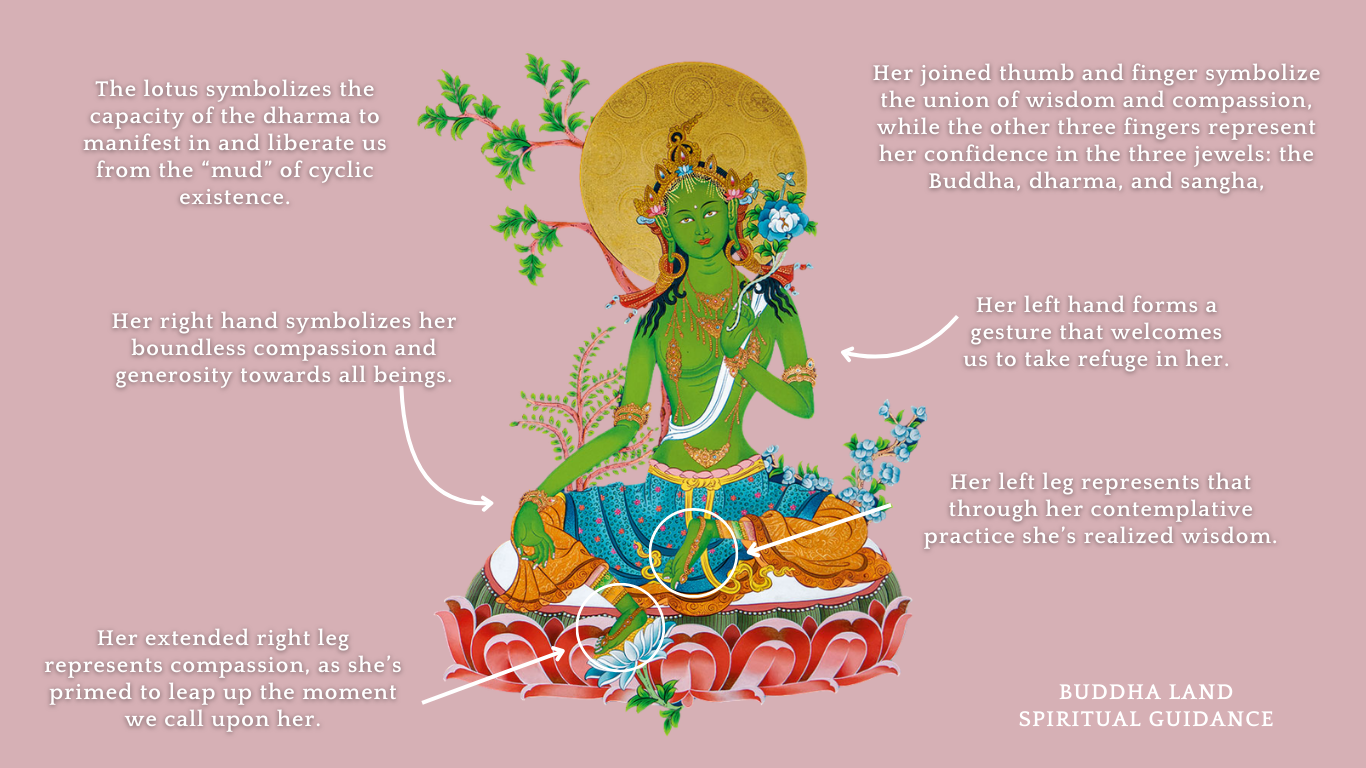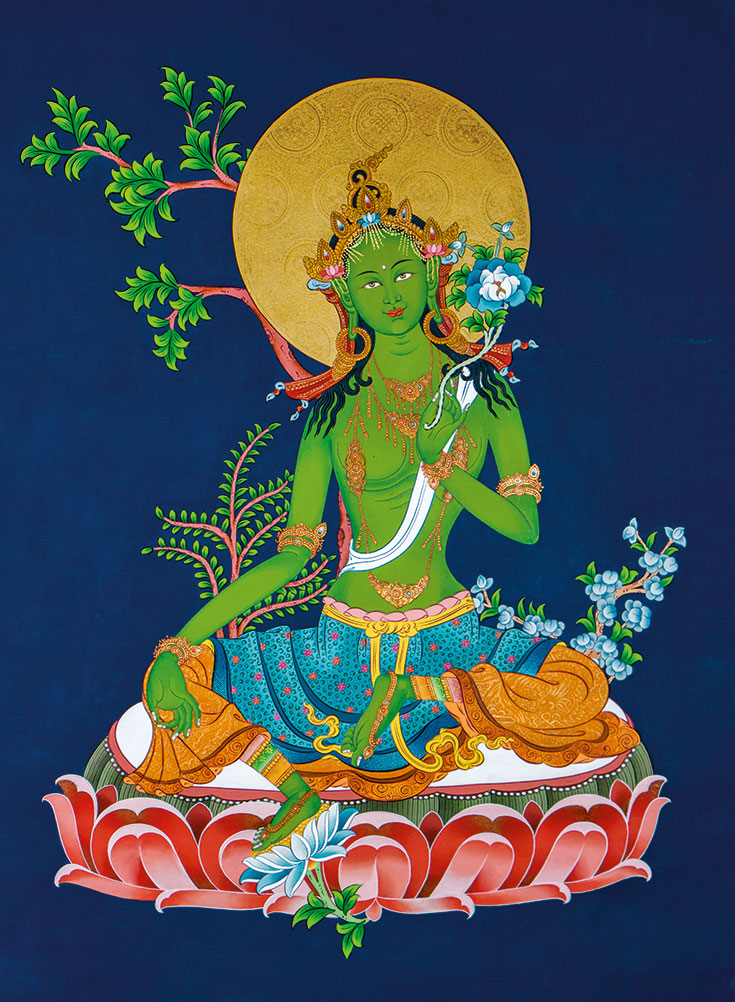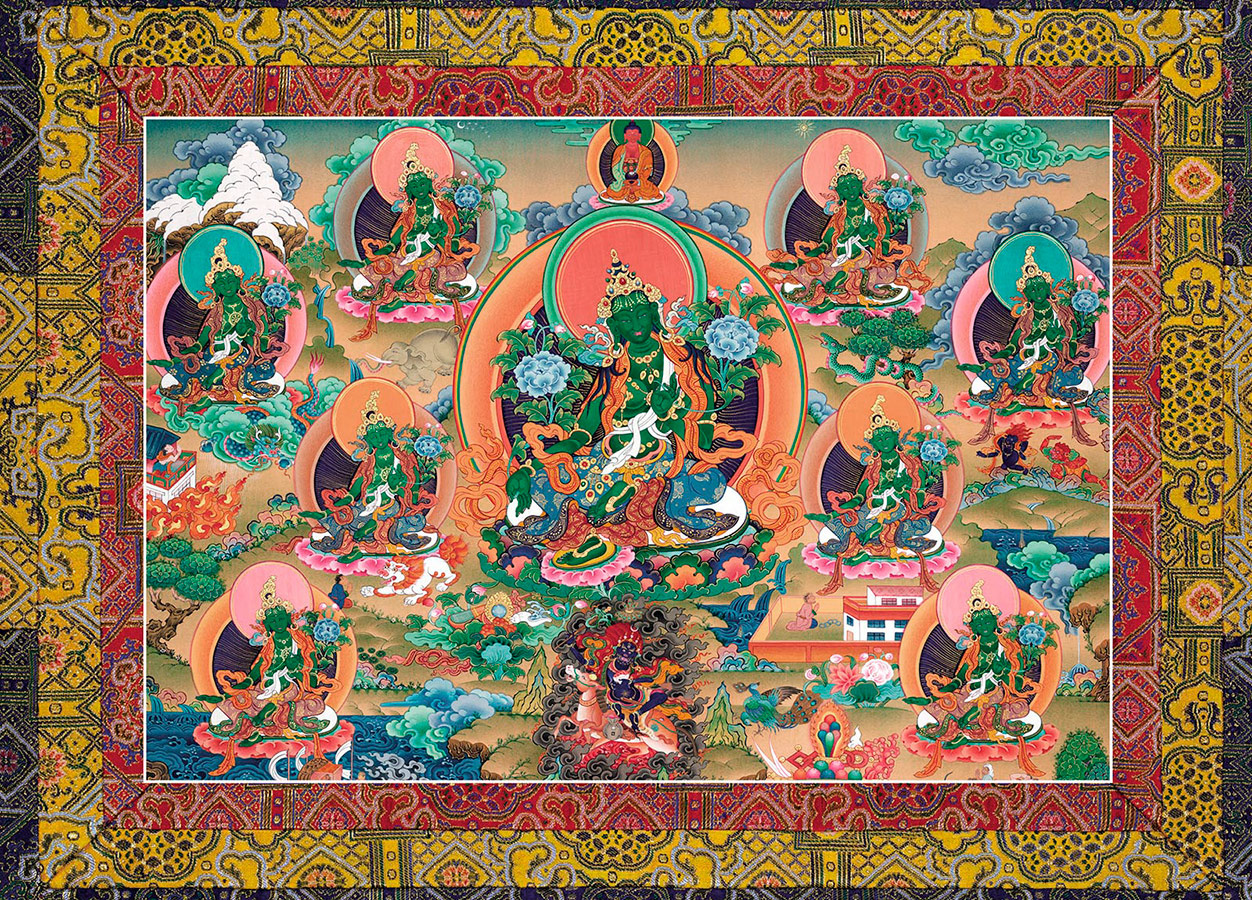Tara is an important figure in Buddhism and arguably the most beloved deity in Mahayana Buddhism, appearing as a female bodhisattva in Mahayana Buddhism and as a female Buddha in Vajrayana Buddhism. “Tara” means “the liberator,” freeing us from ignorance, the root of cyclic existence, and from self-centered thought, which hinders the attainment of full awakening as a Buddha.
According to Vajrayana Buddhism, Tara is a completely enlightened Buddha who, in the distant past, vowed to always manifest in female form for the benefit of all beings after achieving complete enlightenment.
Tara appears in different colors and levels of wrathfulness, with varying numbers of faces, arms, and legs. The most common form is Green Tara, primarily serving as a savior. White Tara symbolizes longevity, while Red Tara represents power.
Green Tara, with her half-open lotus, symbolizes the night, while White Tara, with her lotus in full bloom, represents the day. Green Tara embodies virtuous activity, while White Tara exudes serenity and grace. Together, they symbolize the boundless compassion of the goddess, tirelessly working day and night to alleviate suffering.
Tara serves as a guardian against the eight and sixteen fears, including water, lions, fire, snakes, elephants, thieves, false imprisonment, and ghosts. While these fears have literal interpretations, they also hold deeper inner and secret meanings in Tantric Buddhism’s three-tiered interpretive model: outer, inner, and secret.
For Tibetans the two practices that everybody is doing, whether you are in the monastery or outside the monastery, are Tara, or at least the praises to Tara, and Avaloketishvara, the mani-mantra and the praises to Tara. Majority of Buddhist knows these mantras by heart. Everybody chants them; when you are riding on busses, in dangerous situations and when you feel scared. Chanting mantras of Tara is believed to help overcoming fear and obstacles.
When requesting Tara to free us, we are actually calling upon our inner Tara—the seeds of our own wisdom and compassion. As we gradually cultivate these qualities, they protect us from the damage inflicted by the disturbing emotions.
How does Tara liberate and protect us from danger and fear?
She cannot make a problematic situation magically disappear. The fundamental way Tara—or any other buddha—benefits sentient beings is by teaching us the dharma and inspiring us to investigate its meaning so we reach a correct understanding.
Green Tara: Symbols, Depiction, Benefits
Green Tara, a prominent figure in Tibetan Buddhism, is revered as a compassionate bodhisattva embodying enlightened activity. Symbolizing active compassion and swift intervention, she is often depicted seated gracefully with one leg extended, ready to spring into action to aid those in need. The color green, representing growth, vitality, and renewal, underscores her role as a source of healing and protection.
In artistic representations, Green Tara is typically adorned with flowing garments, jewels, and a crown, signifying her regal presence and spiritual authority. Her right hand is often extended in the gesture of granting boons, symbolizing her readiness to bestow blessings and fulfill the wishes of devotees. Meanwhile, her left hand, positioned in the gesture of refuge, symbolizes protection and assistance to those seeking solace from life’s challenges.

Devotion to Green Tara is believed to bring various benefits to practitioners. She is revered as a source of courage, wisdom, and guidance, helping individuals navigate the obstacles on their spiritual journey. By invoking her compassionate presence through prayers, mantras, or meditation, devotees seek her assistance in overcoming fear, obstacles, and suffering, and in cultivating qualities such as compassion, resilience, and inner peace. Ultimately, Green Tara serves as a beacon of hope and compassion, inspiring countless followers to embark on the path of enlightenment and altruistic action.
Green Tara mantra:
Om Tare Tuttare Ture Svaha
Chanting the Green Tara mantra and visualizing her emerald-green form made of light, we contemplate the path and internalize its meaning, as each aspect of her form represents an aspect of the path to awakening.
Om: It has to do with the body, the mind, and the approach to universal divinity.
Tare: It’s the liberation of the sufferings, feelings, and inferior strength.
Tuttare: It represents protection against internal and external dangers.
Ture: It’s a protection against physical diseases and a peace-generating word.
Svaha: an exclamation meaning “hail” or “may blessings be upon” and is a common ending to Buddhist mantras.
During these uncertain, troubling years, His Holiness the Dalai Lama — when asked for spiritual advice on the pandemic — suggested that chanting the Green Tara mantra could be helpful.
Chanting the Green Tara mantra and visualizing her emerald-green form made of light, we contemplate the path and internalize its meaning, as each aspect of her form represents an aspect of the path to awakening.
Ordinary Tibetans recite Green Tara Mantra when sick, hoping for success, or when leaving for a long journey.
Green Tara mantra helps to liberate the practitioners from the misery of the mental delusions and negative emotions. By chanting them mantra regularly our minds will become crystal clear and we will achieve the same enlightened body, speech and mind that Tara represents, not only for our own benefit, but for the benefit of all sentient beings.
White Tara: Learn More Here

Painting Courtesy of Lucky Thanka, www.luckythanka.com



